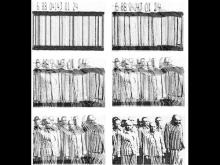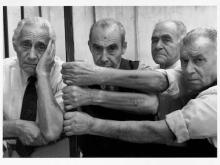The Number on Great-Grandpa’s Arm
THE NUMBER ON GREAT-GRANDPA’S ARM, Amy Schatz, USA 2018
THE NUMBER ON GREAT-GRANDPA’S ARM is a documentary short film about the Auschwitz survivor Srulek Feldman told from the perspective of his great-grandson, Elliott. The short film starts with archival footage and an introduction narrated by Elliott. When his grandfather Srulek takes over and starts to tell about his life before the war, the short film switches from archival films and photographs to animated watercolour adaptations, signalling the transition from photographic items as documents to the more personal memory of the protagonist. A postcard of Srulek’s hometown Sosnowiec near Katowice, Poland, triggers the process of transition from photorealism to watercolour. Srulek’s family memories are illustrated with animated watercolour adaptations of coloured home movies. When official “history” becomes part of the story, the transition process from photo to animation is repeated: a film sequence of marching troopers from Leni Riefenstahl’s TRIUMPH OF THE WILL turns into animated watercolour and represents the intrusion of the Nazis as part of Srulek’s family memory. From there, iconic and generic archival footage in the form of animated watercolour accompanies the narration of the Holocaust survivor. In addition to iconic images from the deportation in Budapest, roundups in Bromberg, deportations in Poland, and Westerbork, the Netherlands, there are also sequences with liberation films from Auschwitz. The sequence with the children showing their Number Tattoos contradictorily illustrates a passage about Srulek’s arrival in Auschwitz.
THE NUMBER ON GREAT-GRANDPA’S ARM indiscriminatingly uses perpetrator and liberation films for its depiction of the survivor story. Therefore, the indirect use of the children showing their Number Tattoo is, strictly speaking, decontextualised. At the same time, it is a specific illustration, as it shows under-age Auschwitz survivors, a group Srulek belongs to. The fact that the liberation footage is used here to illustrate the suffering of a camp inmate during occupation is owed to these iconic images having long ago been transformed into metonyms of the Holocaust, disregarding their indexicality. Due to the absence of perpetrator footage from the camps, the liberation films are used as placeholders and eventually replaced them in the collective memories. THE NUMBER ON GREAT-GRANDPA’S ARM is a vivid example of how perpetrator and liberation images have been amalgamated into a corpus of archival films and photos that represent the Holocaust today.





